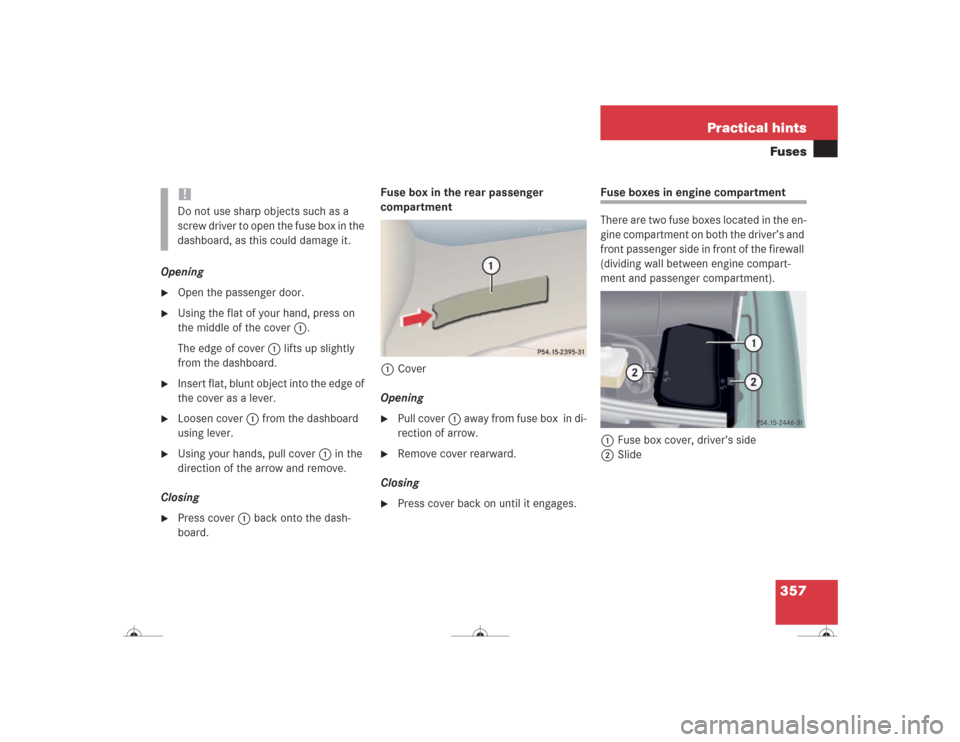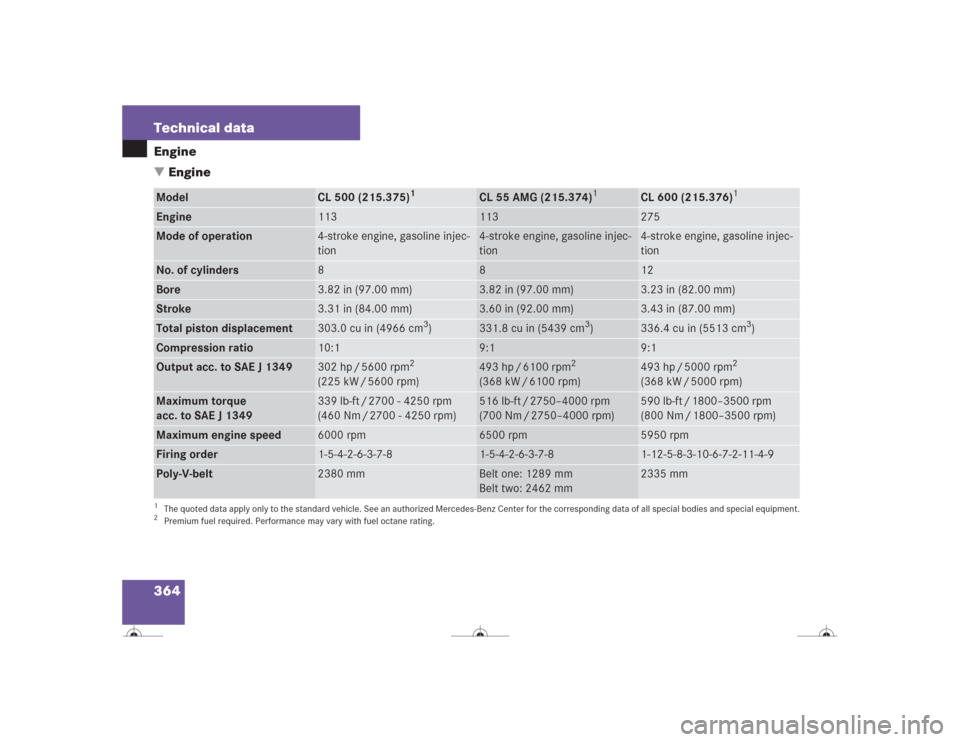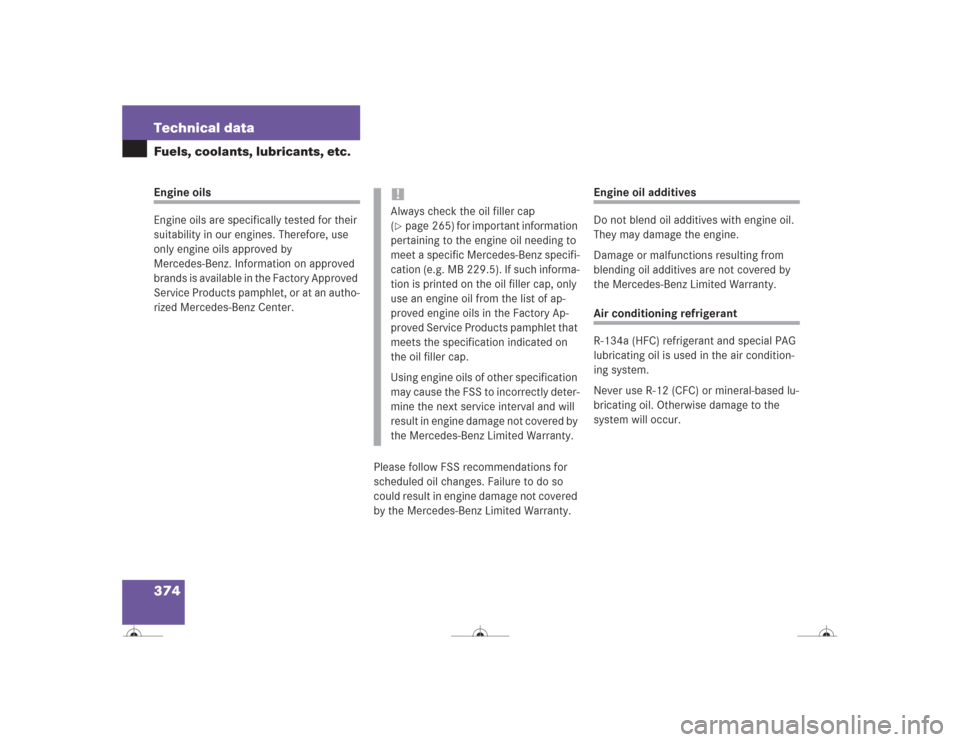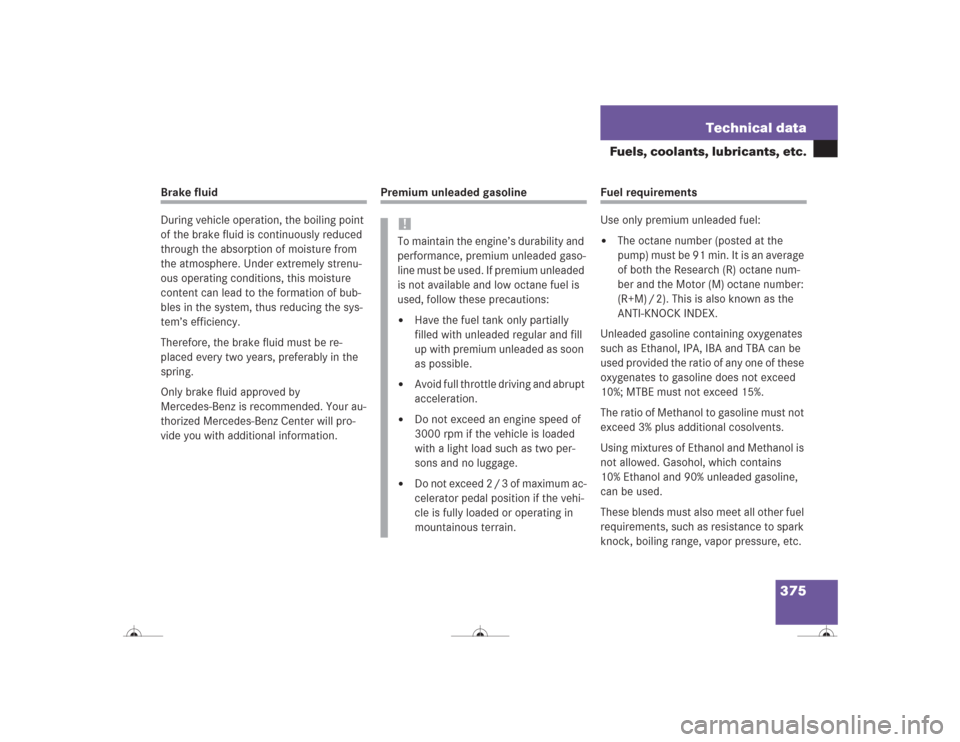Page 358 of 418

357 Practical hintsFuses
Opening�
Open the passenger door.
�
Using the flat of your hand, press on
the middle of the cover1.
The edge of cover1 lifts up slightly
from the dashboard.
�
Insert flat, blunt object into the edge of
the cover as a lever.
�
Loosen cover1 from the dashboard
using lever.
�
Using your hands, pull cover1 in the
direction of the arrow and remove.
Closing
�
Press cover1 back onto the dash-
board.Fuse box in the rear passenger
compartment
1Cover
Opening
�
Pull cover1 away from fuse box in di-
rection of arrow.
�
Remove cover rearward.
Closing
�
Press cover back on until it engages.
Fuse boxes in engine compartment
There are two fuse boxes located in the en-
gine compartment on both the driver’s and
front passenger side in front of the firewall
(dividing wall between engine compart-
ment and passenger compartment).
1Fuse box cover, driver’s side
2Slide
!Do not use sharp objects such as a
screw driver to open the fuse box in the
dashboard, as this could damage it.
Page 359 of 418
358 Practical hintsFuses1Fuse box cover, front passenger side
2Slide
Opening�
Push both slides2 to the Πsym-
bol.
�
Remove cover1.Closing
�
Replace cover1 and press it down by
hand.
�
Push both slides 2 to the ‹ sym-
bol.
Emergency engine shut-down
If the engine can no longer be stopped us-
ing the SmartKey or the KEYLESS-GO*
start/stop button, the engine can be
turned off by withdrawing two fuses.
For easy removal of fuses, use the fuse ex-
tractor (supplied with vehicle tool kit) to
pull out the fuses marked on the fuse chart
as “ENGINE EMERGENCY STOP”.
The fuse chart is also located in the vehicle
tool kit (
�page 329).
!The cover must fit properly and the
slide must be positioned at the ‹
symbol, as moisture or dirt may impair
the functionality of the fuses.
Page 360 of 418
359 Technical data
Spare parts service
Warranty coverage
Identification labels
Layout of poly-V-belt drive
Engine
Rims and Tires
Electrical system
Main Dimensions and weights
Fuels, coolants, lubricants, etc.
Consumer information
Page 363 of 418
362 Technical dataIdentification labels
�Identification labels1Certification label
(on driver’s B pillar)2Vehicle Identification Number (VIN)
(below right rear passenger seat)3Engine number (engraved on engine)
4VIN, visible (lower edge of windshield)
5Information label, California version
Vacuum line routing for emission con-
trol system
6Emission control label
When ordering spare parts, please specify
vehicle identification and engine numbers.
Page 365 of 418

364 Technical dataEngine
�EngineModel
CL 500 (215.375)
1
1The quoted data apply only to the standard vehicle. See an authorized Mercedes-Benz Center for the corresponding data of all special bodies and special equipment.
CL 55 AMG (215.374)
1
CL 600 (215.376)
1
Engine
113
113
275
Mode of operation
4-stroke engine, gasoline injec-
tion
4-stroke engine, gasoline injec-
tion
4-stroke engine, gasoline injec-
tion
No. of cylinders
8
8
12
Bore
3.82 in (97.00 mm)
3.82 in (97.00 mm)
3.23 in (82.00 mm)
Stroke
3.31 in (84.00 mm)
3.60 in (92.00 mm)
3.43 in (87.00 mm)
Total piston displacement
303.0 cu in (4966 cm
3)
331.8 cu in (5439 cm
3)
336.4 cu in (5513 cm
3)
Compression ratio
10:1
9:1
9:1
Output acc. to SAE J 1349
302 hp / 5600 rpm
2
(225 kW / 5600 rpm)
2Premium fuel required. Performance may vary with fuel octane rating.
493 hp / 6100 rpm
2
(368 kW / 6100 rpm)
493 hp / 5000 rpm
2
(368 kW / 5000 rpm)
Maximum torque
acc. to SAE J 1349
339 lb-ft / 2700 - 4250 rpm
(460 Nm / 2700 - 4250 rpm)
516 lb-ft / 2750–4000 rpm
(700 Nm / 2750–4000 rpm)
590 lb-ft / 1800–3500 rpm
(800 Nm / 1800–3500 rpm)
Maximum engine speed
6000 rpm
6500 rpm
5950 rpm
Firing order
1-5-4-2-6-3-7-8
1-5-4-2-6-3-7-8
1-12-5-8-3-10-6-7-2-11-4-9
Poly-V-belt
2380 mm
Belt one: 1289 mm
Belt two: 2462 mm
2335 mm
Page 373 of 418

372 Technical dataFuels, coolants, lubricants, etc.
�Fuels, coolants, lubricants, etc.CapacitiesVehicle components and their respective
lubricants must match. Therefore use only
brands tested and approved by us.Please refer to the Factory Approved Ser-
vice Products pamphlet, or inquire at your
Mercedes-Benz Center.
Model
Capacity
Fuels, coolants, lubricants, etc.
Engine with oil filter
CL 500
CL 55 AMG
CL 600
8.5 US qt (8.0 l)
7.9 US qt (7.5 l)
9.5 US qt (9.0 l)
Approved engine oils
Automatic transmission
CL 500
CL 55 AMG
CL 600
9.1 US qt (8.6 l)
9.1 US qt (8.6 l)
8.1 US qt (7.7 l)
MB Automatic Transmission Oil
Rear axle
CL 55 AMG
and CL 600
1.7 US qt (1.6 l)
2.1 US qt (2.0 l)
Hypoid gear oil SAE 85 W 90
Hydraulic system for ABC
approx. 4.2 US qt (4.0 l)
MB Hydraulic fluid
Power steering
approx. 1.1 US qt (1.0 l)
MB Power Steering Fluid
(Pentosin CHF 11S)
Front wheel hubs
approx. 3.5 oz (100 g) each
High temperature roller bearing grease
Brake system
0.7 US qt (0.7 l)
MB Brake Fluid (DOT 4+)
Cooling system
CL 500
CL 55 AMG
CL 600
approx. 12.1 US qt (11.5 l)
approx. 15.3 US qt (14.5 l)
approx. 15.85 US qt (15 l)
MB 325.0 Anticorrosion / Antifreeze
Page 375 of 418

374 Technical dataFuels, coolants, lubricants, etc.Engine oils
Engine oils are specifically tested for their
suitability in our engines. Therefore, use
only engine oils approved by
Mercedes-Benz. Information on approved
brands is available in the Factory Approved
Service Products pamphlet, or at an autho-
rized Mercedes-Benz Center.
Please follow FSS recommendations for
scheduled oil changes. Failure to do so
could result in engine damage not covered
by the Mercedes-Benz Limited Warranty.
Engine oil additives
Do not blend oil additives with engine oil.
They may damage the engine.
Damage or malfunctions resulting from
blending oil additives are not covered by
the Mercedes-Benz Limited Warranty.Air conditioning refrigerant
R-134a (HFC) refrigerant and special PAG
lubricating oil is used in the air condition-
ing system.
Never use R-12 (CFC) or mineral-based lu-
bricating oil. Otherwise damage to the
system will occur.
!Always check the oil filler cap
(�page 265) for important information
pertaining to the engine oil needing to
meet a specific Mercedes-Benz specifi-
cation (e.g. MB 229.5). If such informa-
tion is printed on the oil filler cap, only
use an engine oil from the list of ap-
proved engine oils in the Factory Ap-
proved Service Products pamphlet that
meets the specification indicated on
the oil filler cap.
Using engine oils of other specification
may cause the FSS to incorrectly deter-
mine the next service interval and will
result in engine damage not covered by
the Mercedes-Benz Limited Warranty.
Page 376 of 418

375 Technical data
Fuels, coolants, lubricants, etc.
Brake fluid
During vehicle operation, the boiling point
of the brake fluid is continuously reduced
through the absorption of moisture from
the atmosphere. Under extremely strenu-
ous operating conditions, this moisture
content can lead to the formation of bub-
bles in the system, thus reducing the sys-
tem’s efficiency.
Therefore, the brake fluid must be re-
placed every two years, preferably in the
spring.
Only brake fluid approved by
Mercedes-Benz is recommended. Your au-
thorized Mercedes-Benz Center will pro-
vide you with additional information.
Premium unleaded gasoline
Fuel requirements
Use only premium unleaded fuel:�
The octane number (posted at the
pump) must be 91 min. It is an average
of both the Research (R) octane num-
ber and the Motor (M) octane number:
(R+M) / 2). This is also known as the
ANTI-KNOCK INDEX.
Unleaded gasoline containing oxygenates
such as Ethanol, IPA, IBA and TBA can be
used provided the ratio of any one of these
oxygenates to gasoline does not exceed
10%; MTBE must not exceed 15%.
The ratio of Methanol to gasoline must not
exceed 3% plus additional cosolvents.
Using mixtures of Ethanol and Methanol is
not allowed. Gasohol, which contains
10% Ethanol and 90% unleaded gasoline,
can be used.
These blends must also meet all other fuel
requirements, such as resistance to spark
knock, boiling range, vapor pressure, etc.
!To maintain the engine’s durability and
performance, premium unleaded gaso-
line must be used. If premium unleaded
is not available and low octane fuel is
used, follow these precautions:�
Have the fuel tank only partially
filled with unleaded regular and fill
up with premium unleaded as soon
as possible.
�
Avoid full throttle driving and abrupt
acceleration.
�
Do not exceed an engine speed of
3000 rpm if the vehicle is loaded
with a light load such as two per-
sons and no luggage.
�
Do not exceed 2 / 3 of maximum ac-
celerator pedal position if the vehi-
cle is fully loaded or operating in
mountainous terrain.